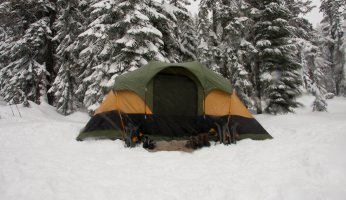Synthetic vs Down: Which Insulation Is Better For The Cold
 Synthetic vs Down: Which Insulation Is Better For The Cold
gearweare.net
Synthetic vs Down: Which Insulation Is Better For The Cold
gearweare.net
The right sleeping bag can make all the difference while camping in the winter. Curled up in a toasty warm bag, temperatures can dip into the teens or single digits and you’ll barely notice. Having a bag with the right temperature rating is crucial to comfort on chilly nights, but that is not the only factor at play here. What type of insulation is inside your bag is also crucial to how warm you stay during the coldest nights.
There are two types of insulation that are used in sleeping bags: synthetic and down. Both have their advantages and disadvantages, but down is decidedly better for keeping you cozy when the freezing temperatures come. However, although down may offer more warmth, synthetic can still be a good choice and the temperature ratings given for any quality bag should be trusted. In the paragraphs below I give an overview of how each of these insulations work and explain why down is a better choice for the cold even though synthetic will get the job done.
Synthetic insulation, which is most often made from polyester fibers, is far cheaper than down because it is quite easy to manufacture. The other main benefit of this type of filling is that it continues to keep you warm even when wet and dries very quickly. This makes synthetic insulation a good choice if you are afraid that your sleeping bag may be exposed to water en route to your campsite, primarily a concern for rafters and backpackers. However, synthetic insulation is also much heavier than down even when the bags have the same temperature ratings, which is a distinct disadvantage for these same groups.
When it comes to winter camping, synthetic insulation’s innate breathability is a clear drawback. Although this quality helps regulate your temperature and is therefore quite helpful in synthetically lined jackets, while slumbering on a frigid night you want your sleeping bag to hold all the heat it can. Because of this characteristic, synthetic insulation creates a sleeping bag that is far less cozy than one lined with down.
Many people mistakenly think that down sleeping bags are lined with feathers, when in fact it is the fluffy under feathers of geese and ducks that are used to fill these bags. These soft, delicate fibers are used for their warmth and their ability to expand and compress easily. The quality of down insulation is gaged by fill power, which is a measurement of how many cubic inches one ounce of down can occupy. The higher the fill power the more light weight a down sleeping bag will be without losing any of its warmth. Premium goose down can have fill power as high as 900 cubic inches per ounce.
The primary drawback with down insulation is that is loses its ability to keep you warm when wet and can take a long time to dry out. After it has dried there is also a chance that the down will be clumpy, meaning that whatever fill power it had before will be rendered irrelevant and the temperature rating will no longer be truthful. However, new technology in dry bags means it has become easy to keep your down sleeping bag dry even while backpacking in the rain. This solves the one major downside of using a down sleeping bag during any season and all types of weather. Much lighter weight than synthetic and with a greater ability to trap heat and keep you warm, down insulated sleeping bags are the obvious choice for winter camping.
As great as down is though, demand for products made with this insulation is higher than supply, making merchandise that utilizes it very expensive. If you would like to invest in a sleeping bag that has down filling, but cannot quite manage the expensive price point another option is to buy a sleeping bag that is a mix of both down and synthetic insulation. Sometimes these bags are simply a blend of the two types of fibers, but retailers will also strategically place each fiber in different areas of the bag so as to best utilize its positive qualities. For example, the REI Flash sleeping bag uses down on the top of the bag, which traps body heat and keeps you warm, and synthetic insulation along the bottom, which helps to make the bag more affordable.
Sleeping bags the use synthetic and down together balance the best qualities offered by both types of insulation. They are lighter weight and retain heat more easily than synthetically insulated bags, while also preforming better when wet and drying quicker than down sleeping bags. In many ways they can be the best of both worlds, creating a sleeping bag that preforms great and doesn’t break the bank. However, in terms of overall ability to keep you cozy and warm in the middle of winter, fully down sleeping bags remain the number one choice.











